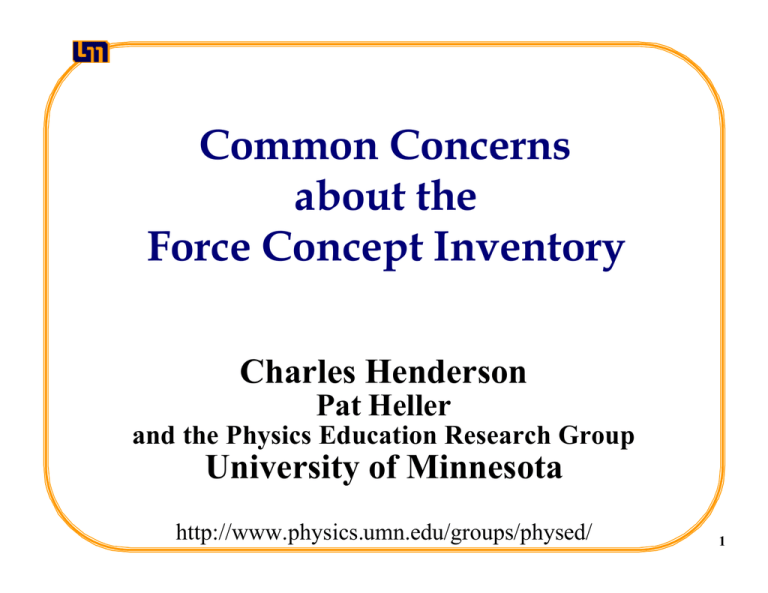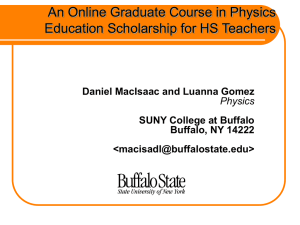Common Concerns about the Force Concept Inventory Charles Henderson
advertisement

Common Concerns about the Force Concept Inventory Charles Henderson Pat Heller and the Physics Education Research Group University of Minnesota http://www.physics.umn.edu/groups/physed/ 1 Introduction Why do we care about the FCI? • Quality Assurance Quick and Easy to Administer Robust Responds to Changes in Instruction • Widely Used 2 U of MN Introductory Calc-Based Physics •Traditional format: 3 hours of lecture, one 2-hour lab, one 1-hour recitation each week •Goal of course is to learn physic through problemsolving; •Non-traditional pedagogy: Cooperative Group Problem-Solving FCI Testing •Pre Test ⇒ first week of labs (ungraded) •Post Test ⇒ as part of final exam (graded) or last week of labs (ungraded) 3 Common Concerns about the FCI Question Response 1. Can FCI pre test be used as a diagnostic test? No 2. Does the FCI post test correlate with desired course outcomes (problem solving grades)? 3. Do students take the FCI seriously when it is not graded? Somewhat (r~0.51) Yes 4 Common Concerns about the FCI Question Response 4. Does giving the FCI as a pre test bias post test results? No 5. Who gains? 6. Are there gender differences in FCI scores? All Students Yes 5 Question #1 Question: Can FCI pre test be used as a diagnostic test? Method: Look at the correlation between FCI pre test scores and desired course outcome (grades on written problems on the final exam). 6 Typical Final Exam Problems Introductory Calculus-Based Physics 1. On the way to work, you drive along a curved section of highway which gets extremely slippery in bad winter weather. You want to know how fast you can drive around the curve without having to rely on the friction between your worn-out tires and the slippery road. You estimate that the banking of that section of the road is about 5º relative to the horizontal and the radius of curvature is 200 m. How fast can you drive safely? 2. In the diagram shown below, block 1 of mass 1.5 kg and block 2 of mass 4 kg are connected by a light taut rope that passes over a frictionless pulley. Block 2 is just over the edge of the ramp inclined at an angel of 30 o, and the blocks have a coefficient of sliding friction of 0.21 with the surface. At time t = 0, the system is given an initial speed of 11 m/s that starts block 2 down the ramp. vo (a) Find the tension in the rope. m1 (b) Find the speed of the two masses at t = 2 s. m2 30o 7 FCI Pre vs. PS Grade F97, F98, F99 N=1645 2.0 1.5 1.0 1 Standard Deviation 0.5 PS Z-Score 26 36 0.0 -0.5 27 58 58 39 39 33 74 111 111 52 20 85 115 116 129 83 99 109 117 Best Fit: Y=.057x - .738 r = 0.34 36 -1.0 -1.5 Average FCI Pre Score = 13.6 -2.0 0 5 10 Number of students shown below each data point 15 FCI Pre Score 20 25 30 8 Question #2 Question: Does the FCI post test correlate with desired course outcomes (problem solving grades)? Method: Look at the correlation between FCI post test scores and desired course outcome (grades on written problems on the final exam). 9 FCI Post vs. PS Grade F97, F98, F99 N=1818 2.0 1.5 1.0 41 90 80 113 99 114 102 114 0.0 93 103 100 111 -0.5 Best Fit: Y=.087x - 1.746 r = 0.51 -1.0 1 Standard Deviation PS Z-Score 0.5 90 92 93 78 24 44 57 65 53 27 -1.5 Average FCI Post Score = 20.5 -2.0 0 5 10 Number of students shown below each data point 15 FCI Post Score 20 25 30 10 Question #3 Question: Do students take the FCI seriously when it is not graded? Method: Look for differences between ungraded FCI tests and graded FCI tests • Obvious lack of seriousness • Subtle lack of seriousness 11 Obvious Lack of Seriousness Lack of Seriousness % of Students for Ungraded* •Refuse to take test ~0.5% •Draws a picture ~0.2% •Answers all A’s, B’s, etc. none found •Leaves a lot of blanks (6 or more) ~1.5% •Other systematic patterns ~0.2% *Based on data from N=1818 introductory Calculus-Based physics students at the University of Minnesota from 1997-1999. 12 Subtle Lack of Seriousness FCI Score (N=500) Fall 1997 (On Final Exam) 71.4% Winter 1998 (Ungraded in Lab) 69.8% Difference* 1.6% (~0.5 FCI items) *Significant difference on a matched sample t-test 13 Test-Retest Comparison N=500, r=0.88 30 W98 Pre (Ungraded in Lab) 34% had higher score 25 an average of 2.3 pts. 20 15 18% had same score 10 48% had lower score 5 an average of -2.7 pts. 2 Standard Deviations 0 0 5 10 15 20 25 30 F97 Post (On Final Exam) 14 Seriousness FCI Gains No significant differences in FCI relative gain by the same professor between years when the post test is graded and when the post test is ungraded. University of Minnesota, 1996-1999 Introductory Calculus-Based Physics 0.60 Relative Gain <g> 0.50 0.40 0.30 0.20 0.10 1996 Post Test In Lab 1997 Post Test On Final 1998 Post Test On Final 1999 Post Test In Lab 0.00 M* G N* G O* P* O K D N P G O G N M O K Q* Lecture Section each letter represents a different instructor I - Standard Error of the Mean * - First Time With Course 15 Conclusions Question 1. Can FCI pre test be used as a diagnostic test? Correlation between FCI pre test and course outcome (problem solving grades) 2. Does the FCI correlate with desired course outcomes (problem solving grades)? Response No (r~0.34) low slope (0.057) Somewhat (r~0.51) higher slope (0.087) 16 Conclusions Question 3. Do students take the FCI seriously when it is not graded? Response Yes • Most of the ways students don’t take the test seriously are easy to spot (we remove these students from our analysis): Not taking the Test Leaving 6 or more blanks • There is no meaningful difference between FCI scores on a graded test and an ungraded test. 17 Question #4 Question: Does giving the FCI as a pre test bias post test results? Method: Compare post test scores for students who had pre test and students who did not. (Lab groups were ‘randomly’ assigned to the group that received pre test or the group that did not receive the pre test.) 18 Pre Test vs. No Pre Test FCI Post Fall 1998 FCI Pre (N=440) . . . . . . . . . . . . . . 70.5% No FCI Pre (N=161) . . . . . . . . . . . 68.7% No significant difference on a pooled variance t-test (P=0.29) Fall 1999 FCI Pre (N=355) . . . . . . . . . . . . . . . 65.2% No FCI Pre (N=170) . . . . . . . . . . . 64.3% No significant difference on a pooled variance t-test (P=0.63) 19 Question #5 Question: Who gains? Method: Look at the relationship between relative gains on the FCI and pre test scores. 20 Who Gains? FCI pre vs. Relative Gain <g> F97, F98, F99 All N=1648 0.70 0.65 0.60 36 19 0.55 2 0.50 Average <g> = 0.43 58 39 39 4 58 112 Relative Gain <g> 0.45 20 52 109 10 117 85 0.30 115 116 33 27 74 83 112 0.40 0.35 16 130 13 99 26 36 0.25 0.20 0.15 0.10 9 Average Pre Score = 13.6 0.05 0.00 3 -0.05 0 1 2 3 4 5 6 7 8 9 10 11 12 13 14 15 16 17 18 19 20 21 22 23 24 25 26 27 28 29 30 31 FCI Pre Score I = Standard Error of Mean 21 Question #6 Question: Are there gender differences in FCI scores? Method: Compare the relationship between pre test and post test scores for males and females. 22 Gender Differences FCI pre vs. FCI post F97, F98, F99 All, Binned by 2 N=392 Female, N=1233 Male Each point represents at least 10 students 30.0 28.0 26.0 24.0 Average Post Score = 20.6 22.0 FCI Post Score 20.0 18.0 Female 16.0 Male 14.0 12.0 10.0 8.0 Average Pre Score = 13.6 6.0 4.0 2.0 0.0 0 1 2 3 4 5 6 7 8 9 10 11 12 13 14 15 16 17 18 19 20 21 22 23 24 25 26 27 28 29 30 31 FCI Pre Score I = Standard Error of Mean 23 FCI Measurement Error Standard Error of Measurement = 2.18 items •Based on Post Test data from Fall 1998 (similar for other years and pre test) N = 709 Ft = 5.45 items " = 0.84 (Cronbach alpha) •Standard error of measurement is related to reliability Fe = Ft √ 1 - " Fe → Standard error of measurement Ft → Standard error of distribution of obtained scores " → Reliability of test • This relationship comes from: 1) F2total = F2true + F2error 2) Reliability = F2true / F2total = 1 - F2error / F2total 24



